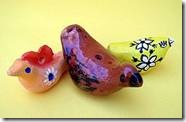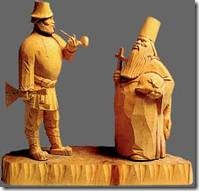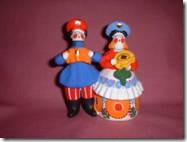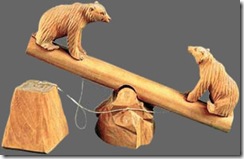The History of Russian Toys
Written by Vadim on March 3, 2009 – 12:00 am -
 Like cultures all over the globe, Russians have been collecting, playing with, and displaying toys for their entire history. Russian toys are unique, however, in that they have had influences from a wide variety of cultures and religions. Because they are the most abundant natural materials in Russia, wood and clay are the two most common ingredients of traditional Russian toys. Other than this, there are no hard and fast rules or themes.
Like cultures all over the globe, Russians have been collecting, playing with, and displaying toys for their entire history. Russian toys are unique, however, in that they have had influences from a wide variety of cultures and religions. Because they are the most abundant natural materials in Russia, wood and clay are the two most common ingredients of traditional Russian toys. Other than this, there are no hard and fast rules or themes.
Prehistoric Russian Toys: Few toys exist from prehistoric Russia, but they all follow a similar pattern to prehistoric toys found throughout the world. Simple musical instruments such as rattles and whistles have been found at archaeological sites as well as figurines of humans and animals that may have been rooted in religion and spirituality.
 Slavic Era: Russia’s first existence as a nation and a culture was under the control of the Slavs, which are first recorded in the area before the first millennium AD. The early toys of this time were often in the shape of birds and other animals which had agricultural and/or seasonal significance. Penny whistles were popular as they were part of the worship of the Slavic god Yarilo. Simple wooden rattles and other early musical instruments were popular among adults and children alike.
Slavic Era: Russia’s first existence as a nation and a culture was under the control of the Slavs, which are first recorded in the area before the first millennium AD. The early toys of this time were often in the shape of birds and other animals which had agricultural and/or seasonal significance. Penny whistles were popular as they were part of the worship of the Slavic god Yarilo. Simple wooden rattles and other early musical instruments were popular among adults and children alike.
 Byzantine Era: While the rest of the world was immersed in the Dark Ages, Russia was enjoying a rich and flourishing culture. Russians during this era had toys that could be made at home with simple materials and the skills that were common at that time. A popular toy from this era was a plain wooden statue or figurine depicting a figure or scene from popular folk tales. These were highly detailed and usually unpainted. Toys made in this ancient tradition are still being manufactured, most notably by craftsmen in Bogorodskoe.
Byzantine Era: While the rest of the world was immersed in the Dark Ages, Russia was enjoying a rich and flourishing culture. Russians during this era had toys that could be made at home with simple materials and the skills that were common at that time. A popular toy from this era was a plain wooden statue or figurine depicting a figure or scene from popular folk tales. These were highly detailed and usually unpainted. Toys made in this ancient tradition are still being manufactured, most notably by craftsmen in Bogorodskoe.
 Czarist Era: Dymkovo, small painted clay toys named after the town where they were originally made, date back to the Czarist period of Russia and are also still made in modern times. They are notable because high quality dymkovo can be made at home by laymen. They typically are bright colored, simple, and feature characters and objects from nineteenth century Russian life.
Czarist Era: Dymkovo, small painted clay toys named after the town where they were originally made, date back to the Czarist period of Russia and are also still made in modern times. They are notable because high quality dymkovo can be made at home by laymen. They typically are bright colored, simple, and feature characters and objects from nineteenth century Russian life.
Nesting shapes became popular during this time, both as figurines and as toys. Ornately decorated eggs, apples, and other shapes were common. Toward the end of the nineteenth century, there was a resurgence of interest in traditional Russian crafts, which led to the creation of a ‘national toy’, the Matryoshka, which was ironically modeled after a Japanese nesting doll of similar design.
 Communist Era: While many handicrafts were discouraged, others flourished. The simple wooden toys of eras past regained popularity and were now made to have moving parts. Bears were common, and were often shown eating at a table and performing other typically human activities.
Communist Era: While many handicrafts were discouraged, others flourished. The simple wooden toys of eras past regained popularity and were now made to have moving parts. Bears were common, and were often shown eating at a table and performing other typically human activities.
Modern Era: In an increasingly global economy, Russian children, like children everywhere, are playing with the commercialized toys marketed and sold by global companies. Toys based on Russian television programs are especially popular. However, the fall of the Soviet Union has resulted in a resurgence of folk craft and increased interest in traditional Russian arts and crafts. This, combined with a worldwide demand for Russian toys and memorabilia, is sure to result in a resurgence of distinctively Russian toys.
References:
http://en.wikipedia.org/wiki/Matryoshka_doll
http://en.wikipedia.org/wiki/East_Slav
http://en.wikipedia.org/wiki/Slav
http://en.wikipedia.org/wiki/Dymkovo_toys
http://www.kolinskyartbrushes.com/dymkovo-figurines/
http://www.artrusse.ca/bogorodskoe_en.htm
Tags: history, russian toys, toys, wooden toys
Posted in General | No Comments »



